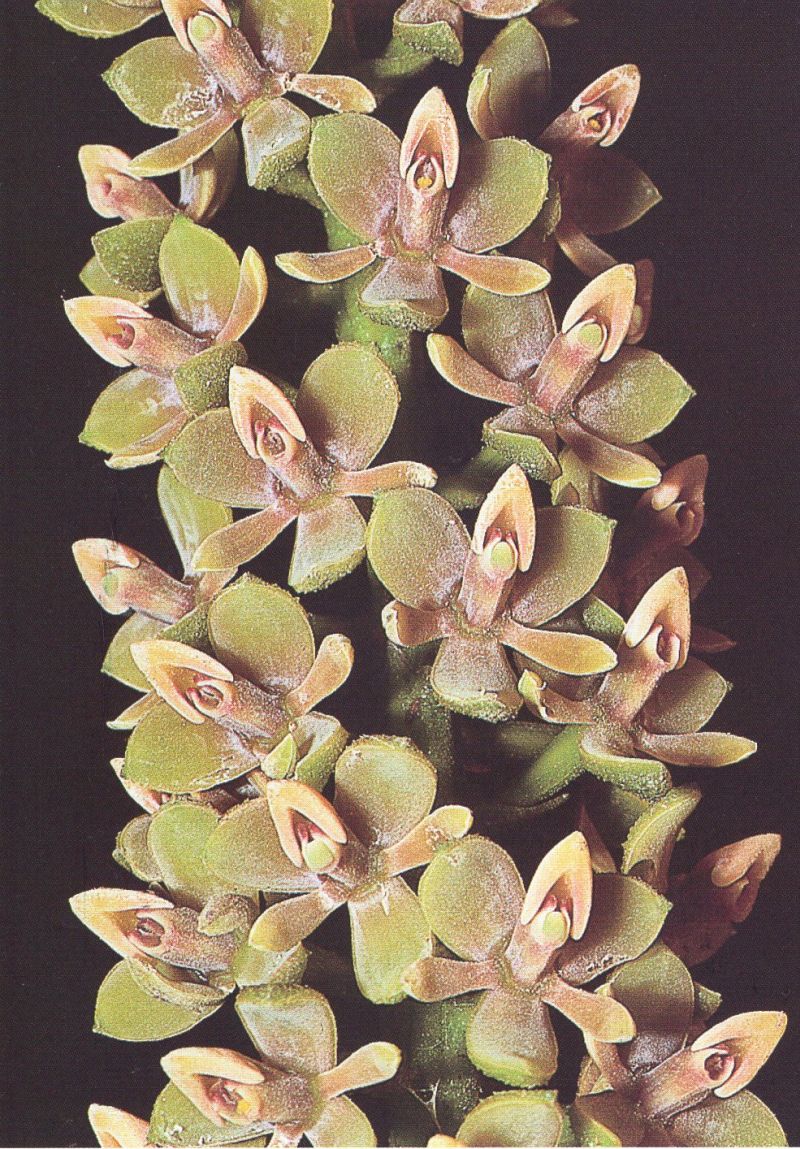

Epidendrum palaciosii Hágsater & Dodson 1993 GROUP Macrostachyum
Photo by © Alexander Hirtz
TYPE Drawing by © Jimenez and The AMO Herbaria Website






Common Name Palacios’ Epidendrum [Ecuadorean Herbarium director current]
Flower Size .8” [2 cm]
Found in Ecuador and the Amazonian slope of the Andes at elevations of 2000 to 2200 meters as a giant sized, cold growing terrestrial with erect, terete, branching in maturity, branches smaller and thinner than main stem, carrying all along the stem, ellitpic-lanceolate, acute, margin finely dentate leaves that blooms at most any time of the year on a terminal, occuring only once, without a spathe, racemose, erect, 3.6 to 8” [9 to 20 cm] long, simultaneously many flowered inflorescence with small, much shorter than the ovary, spreading, acute, cucullate floral bracts and carrying fleshy, non-resupinate, waxy, grey flowers.
"Epidendrum palaciosii is part of GROUP Macrostachyum characterized by the monopodial plants with sub-apical branching, rugose leaf sheaths, large leaves generally spreading, racemose, erect inflorescence, and fleshy flowers generally green to black (ripe olive colored), as well as yellow to pink to purple, with an entire, conduplicate, generally ecallose and pubescent lip embracing the column, and the nectary pubescent to papillose in front of the stigmatic cavity and at least at the base of the lip. The species is distinguished by the floral bracts that are much shorter than the respective ovaries, the muriculate sepals .28 to .32" [7 to 8 mm] long, the very waxy, cordiform lip which can not be spread flatly, and the long, depressed hairs on the lower surface of the nectary, in front of the stigmatic cavity. E. macrostachyum nom illegal = E chondrochilum has flowers about twice the size, glabrous sepals, the lateral ones keeled, and the entire surface of the nectary papillose. E. oxycalyx Hágsater & Dodson has larger, acute leaves, flowers with longer, acuminate segments and inflorescence often paniculate. E. alsum Ridl. ex Oliver has larger flowers and more lax inflorecence." Hagsater etal 1993
Synonyms
References W3 Tropicos, Kew Monocot list , IPNI ; Icones Orchidacearum 2 Plate 163 Hagsater & Dodson 1993 see recognition section; Icones Orchidacearum 2 Plate 168 Hagsater & Dodson 1993 see recognition section; Icones Orchidacearum 2 Plate 169 Hagsater & Dodson 1993 see recognition section; * Icones Orchidacearum 2 Plate 171 Hagsater & Dodson 1993 drawing fide; Icones Orchidacearum 3 Plate 317 Hagsater & Sanchez 1999 see recognition section; Icones Orchidacearum 3 Plate 335 Hagsater & Sanchez 1999 see recognition section; Icones Orchidacearum 3 Plate 389 Hagsater 1999 see recognition section; Icones Orchidacearum 4 Plate 458 Hagsater 2001 see recognition section; Native Ecuadorian Orchids vol 2 Dodson 2001 photo fide; Icones Orchidacearum 13 Plate 1378 Hagsater & Dodson 2010 See Recognition section; Icones Orchidacearum 14 Plate 1452 Hagsater & Sanchez 2013 see recognition section; Icones Orchidacearum 15 [1] Plate 1505 Hagsater & Sanchez 2015 see recognition section; Icones Orchidacearum 15 [1] Plate 1518 Hagsater & Sanchez 2015 see recognition section; Icones Orchidacearum 15 [1] Plate 1545 Hagsater & Sanchez 2015 see recognition section; Icones Orchidacearum 15 [1] Plate 1563 Hagsater & Sanchez 2015 see recognition section; Icones Orchidacearum 15 [2] Plate 1586 Hagsater & Sanchez 2016 see recognition section;
--------------------------------------------------------------------------------------------------------------------------